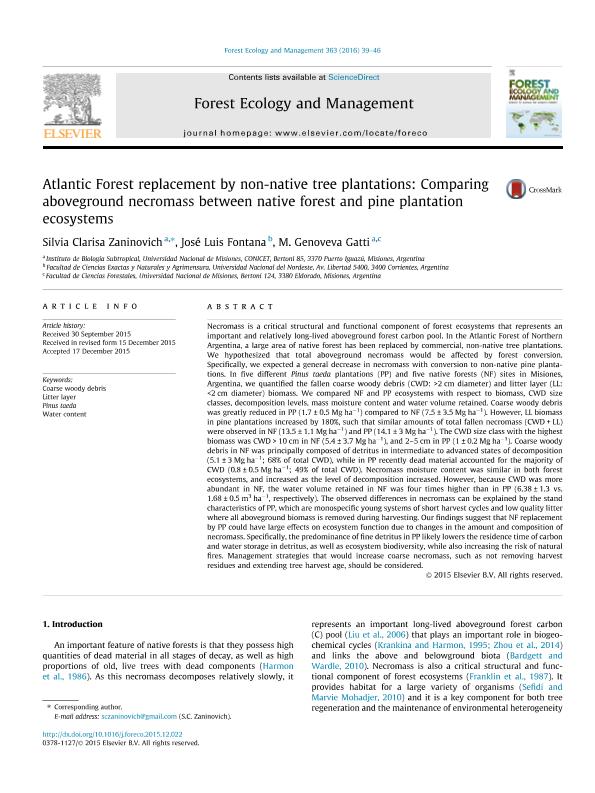Mostrar el registro sencillo del ítem
dc.contributor.author
Zaninovich, Silvia Clarisa

dc.contributor.author
Fontana, José Luis

dc.contributor.author
Gatti, Maria Genoveva

dc.date.available
2018-05-16T17:10:18Z
dc.date.issued
2016-03
dc.identifier.citation
Zaninovich, Silvia Clarisa; Fontana, José Luis; Gatti, Maria Genoveva; Atlantic Forest replacement by non-native tree plantations: Comparing aboveground necromass between native forest and pine plantation ecosystems; Elsevier Science; Forest Ecology and Management; 363; 3-2016; 39-46
dc.identifier.issn
0378-1127
dc.identifier.uri
http://hdl.handle.net/11336/45373
dc.description.abstract
Necromass is a critical structural and functional component of forest ecosystems that represents an important and relatively long-lived aboveground forest carbon pool. In the Atlantic Forest of Northern Argentina, a large area of native forest has been replaced by commercial, non-native tree plantations. We hypothesized that total aboveground necromass would be affected by forest conversion. Specifically, we expected a general decrease in necromass with conversion to non-native pine plantations. In five different Pinus taeda plantations (PP) and five native forests (NF) sites in Misiones, Argentina, we quantified the fallen coarse woody debris (CWD: >2 cm diameter) and litter layer (LL: <2 cm diameter) biomass. We compared NF and PP ecosystems with respect to biomass, CWD size classes, decomposition levels, mass moisture content and water volume retained. Coarse woody debris was greatly reduced in PP (1.7 ± 0.5 Mg ha−1) compared to NF (7.5 ± 3.5 Mg ha−1). However, LL biomass in pine plantations increased by 180%, such that similar amounts of total fallen necromass (CWD + LL) were observed in NF (13.5 ± 1.1 Mg ha−1) and PP (14.1 ± 3 Mg ha−1). The CWD size class with the highest biomass was CWD > 10 cm in NF (5.4 ± 3.7 Mg ha−1), and 2–5 cm in PP (1 ± 0.2 Mg ha−1). Coarse woody debris in NF was principally composed of detritus in intermediate to advanced states of decomposition (5.1 ± 3 Mg ha−1; 68% of total CWD), while in PP recently dead material accounted for the majority of CWD (0.8 ± 0.5 Mg ha−1; 49% of total CWD). Necromass moisture content was similar in both forest ecosystems, and increased as the level of decomposition increased. However, because CWD was more abundant in NF, the water volume retained in NF was four times higher than in PP (6.38 ± 1.3 vs. 1.68 ± 0.5 m3 ha−1, respectively). The observed differences in necromass can be explained by the stand characteristics of PP, which are monospecific young systems of short harvest cycles and low quality litter where all aboveground biomass is removed during harvesting. Our findings suggest that NF replacement by PP could have large effects on ecosystem function due to changes in the amount and composition of necromass. Specifically, the predominance of fine detritus in PP likely lowers the residence time of carbon and water storage in detritus, as well as ecosystem biodiversity, while also increasing the risk of natural fires. Management strategies that would increase coarse necromass, such as not removing harvest residues and extending tree harvest age, should be considered.
dc.format
application/pdf
dc.language.iso
eng
dc.publisher
Elsevier Science

dc.rights
info:eu-repo/semantics/openAccess
dc.rights.uri
https://creativecommons.org/licenses/by-nc-sa/2.5/ar/
dc.subject
Coarse Woody Debris
dc.subject
Litter Layer
dc.subject
Pinus Taeda
dc.subject
Water Content
dc.subject.classification
Otras Ciencias Biológicas

dc.subject.classification
Ciencias Biológicas

dc.subject.classification
CIENCIAS NATURALES Y EXACTAS

dc.title
Atlantic Forest replacement by non-native tree plantations: Comparing aboveground necromass between native forest and pine plantation ecosystems
dc.type
info:eu-repo/semantics/article
dc.type
info:ar-repo/semantics/artículo
dc.type
info:eu-repo/semantics/publishedVersion
dc.date.updated
2018-05-04T20:16:19Z
dc.journal.volume
363
dc.journal.pagination
39-46
dc.journal.pais
Países Bajos

dc.journal.ciudad
Amsterdam
dc.description.fil
Fil: Zaninovich, Silvia Clarisa. Consejo Nacional de Investigaciones Científicas y Técnicas. Centro Científico Tecnológico Conicet - Nordeste. Instituto de Biología Subtropical. Instituto de Biología Subtropical - Nodo Puerto Iguazú | Universidad Nacional de Misiones. Instituto de Biología Subtropical. Instituto de Biología Subtropical - Nodo Puerto Iguazú; Argentina
dc.description.fil
Fil: Fontana, José Luis. Universidad Nacional del Nordeste. Facultad de Ciencias Exactas y Naturales y Agrimensura; Argentina
dc.description.fil
Fil: Gatti, Maria Genoveva. Consejo Nacional de Investigaciones Científicas y Técnicas. Centro Científico Tecnológico Conicet - Nordeste. Instituto de Biología Subtropical. Instituto de Biología Subtropical - Nodo Puerto Iguazú | Universidad Nacional de Misiones. Instituto de Biología Subtropical. Instituto de Biología Subtropical - Nodo Puerto Iguazú; Argentina. Universidad Nacional de Misiones. Facultad de Ciencias Forestales; Argentina
dc.journal.title
Forest Ecology and Management

dc.relation.alternativeid
info:eu-repo/semantics/altIdentifier/url/https://www.sciencedirect.com/science/article/pii/S0378112715007495
dc.relation.alternativeid
info:eu-repo/semantics/altIdentifier/doi/https://doi.org/10.1016/j.foreco.2015.12.022
Archivos asociados
